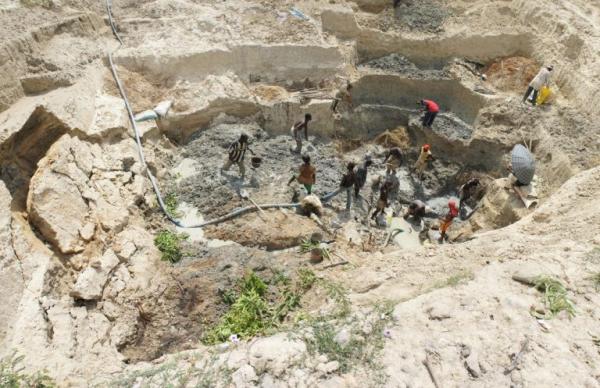Beyond the Glitz and Glamor Lies Artisanal Mining

MICHELLE BRKLJACIC
Artisanal mining of resources such as gold and diamonds has historically attracted the world’s poorest populations, trapping them in a cycle of poverty. In addition, it has also had adverse effects on water and environmental quality.
In an attempt to reduce artisanal mining’s negative impact on the environment and water quality, the Global Water Institute (GWI) at Ohio State began the Artisanal Mining Initiative in 2020. Recently, findings from this initiative have been published as a two-part series in GeoHealth (Schwartz et al., 2021a, b).
Thomas Darrah, executive director of the Global Water Institute, said that the Artisanal Mining Initiative compliments GWI’s ongoing water and health initiatives focused on serving populations of the Global South.

“You quickly get over the glitz and glamor of the gold and precious stones, and the world’s obvious need for strategic materials for renewable energy storage,” Darrah said. “Painfully obvious is the grinding poverty, which commonly attracts people to this work and traps them there, and leads to severe health impacts for miners and major issues for water and environmental quality.”
Men, women, and children all work as miners, using tools such as picks, shovels, buckets, and pans. Examples of these valuable resources include gold and diamonds along rivers and cobalt found in the Democratic Republic of Congo. Much of the production of these sought-after resources comes from artisanal and small-scale mining.

Because artisanal mining often occurs in rural, impoverished communities with small mines, there are significant health risks involved. Miners face risks such as accidents, chemical exposures, dust inhalation, and strenuous work.
Poverty magnifies health risks in these areas because of treatment costs and an absence of medical facilities in rural settings.
New technologies, such as machine learning and artificial intelligence, provide a more detailed picture of health and environmental conditions.
“Violence, criminality, and the immense wealth at stake for a few actors provide little incentive to make robust information available to study the health and environmental effects of artisanal mining available,” Frank Schwartz, earth sciences professor, said. “Progress requires that we jump the innovation curve.”
These innovations are already being implemented for the monitoring of hazards, land use/land cover and climate change impacts. Fully convolutional neural networks allow the automatic tracking of surface features, such as mining impacts, from high-resolution satellite imagery. The Byrd Polar and Climate Research Center at Ohio State is currently using these methods.
Ian Howat, Director of Byrd Polar and Climate Research Center, said “Frequent-refresh, high-resolution commercial imagery gives you the near real-time ‘eye in the sky’ for collecting vast amounts of imagery at regional scales that can be used to investigate various earth processes and anthropogenic activities.”
Complimentary machine learning and sensing-based work is underway through ongoing collaborations between the Byrd Polar and Climate Research Center and Global Water Institute at The Ohio State University as part of their newly formed MoU with the Global Environmental Measurement and Monitoring (GEMM) Initiative.
